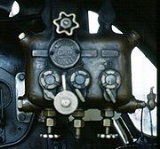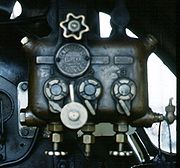
Displacement lubricator
Encyclopedia
A Mechanical lubricator, or automatic lubricator, is a device fitted to a steam engine
to supply lubricating oil
to the cylinders
and, sometimes, the bearings
and axle box mountings as well. There are various types of mechanical lubricator.
in 1860 by John Ramsbottom
. It operates by allowing steam to enter a closed vessel containing oil. After condensing, the water sinks to the bottom of the vessel, causing the oil to rise and overflow into delivery pipes. The oil from the delivery pipes is introduced into the steam pipe, where it is atomised and carried to the valves and cylinders.
In early applications in steam locomotive
s, either two displacement lubricators (one for each cylinder) would be positioned at the front of the boiler near the valves, often on either side of the smokebox
or one lubricator would be placed behind the smokebox. The behind smokebox configuration has the advantage that a good connection can be made to the steam pipe and was used by the Great Western Railway
. It has the disadvantage that the lubricator's accessibility is reduced and additional drain pipes are required to be connected to the waste to avoid it dripping onto the boiler.
Later types of lubricator (from around 1887), referred to as the "sight-feed" type, allowed a sight glass
to be positioned in the cab where the rate of oil feed could be observed.
The displacement lubricator was a useful stop-gap but had the disadvantage that it was difficult to accurately control over the rate of oil feed and lubrication was only supplied when the engine was doing work (when a locomotive is coasting with the regulator closed, no steam is present to operate the lubricator).
In the Ramsbottom type the flow of lubricant depended mainly on the weather. In cold weather the rate of feed would increase because steam would condense more rapidly. The Roscoe type lubricator, improved the situation by providing a valve with which to regulate the flow of steam and hence lubricant. Setting the valve correctly required experience and depended on the speed of the train.
The Roscoe lubricator was invented by James Roscoe in 1862 and patented in British Patent 1337. It incorporated two improvements over the original Ramsbottom type, the ability to control the quantity of steam which entered the lubricator, via a control valve, and the addition of an air filled chamber within the oil reservoir. The chamber expanded when steam was cut off, the aim of which was to supply oil even when the locomotive was coasting. However, this proved ineffective in practice, particularly if the locomotive was coasting for a long time (e.g. down a hill).
When more sophisticated lubricators, such as the Wakefield and Detroit types, were developed, displacement lubricators fell out of use but they are still used on model steam engines .
 This was patented by Charles Wakefield in the 1890s .
This was patented by Charles Wakefield in the 1890s .
Steam engine
A steam engine is a heat engine that performs mechanical work using steam as its working fluid.Steam engines are external combustion engines, where the working fluid is separate from the combustion products. Non-combustion heat sources such as solar power, nuclear power or geothermal energy may be...
to supply lubricating oil
Lubricant
A lubricant is a substance introduced to reduce friction between moving surfaces. It may also have the function of transporting foreign particles and of distributing heat...
to the cylinders
Cylinder (steam locomotive)
The cylinders of a steam locomotive are the components that convert the power stored in the steam into motion.Cylinders may be arranged in several different ways.-Early locomotives:...
and, sometimes, the bearings
Plain bearing
A plain bearing, also known as a plane bearing or a friction bearing is the simplest type of bearing, comprising just a bearing surface and no rolling elements. Therefore the journal slides over the bearing surface. The simplest example of a plain bearing is a shaft rotating in a hole...
and axle box mountings as well. There are various types of mechanical lubricator.
Displacement lubricator
The displacement lubricator was introduced in the United KingdomUnited Kingdom
The United Kingdom of Great Britain and Northern IrelandIn the United Kingdom and Dependencies, other languages have been officially recognised as legitimate autochthonous languages under the European Charter for Regional or Minority Languages...
in 1860 by John Ramsbottom
John Ramsbottom (engineer)
John Ramsbottom was an English mechanical engineer who created many inventions for railways, including the piston ring, the Ramsbottom safety valve, the displacement lubricator, and the water trough.- Biography :...
. It operates by allowing steam to enter a closed vessel containing oil. After condensing, the water sinks to the bottom of the vessel, causing the oil to rise and overflow into delivery pipes. The oil from the delivery pipes is introduced into the steam pipe, where it is atomised and carried to the valves and cylinders.
In early applications in steam locomotive
Steam locomotive
A steam locomotive is a railway locomotive that produces its power through a steam engine. These locomotives are fueled by burning some combustible material, usually coal, wood or oil, to produce steam in a boiler, which drives the steam engine...
s, either two displacement lubricators (one for each cylinder) would be positioned at the front of the boiler near the valves, often on either side of the smokebox
Smokebox
A smokebox is one of the major basic parts of a Steam locomotive exhaust system. Smoke and hot gases pass from the firebox through tubes where they pass heat to the surrounding water in the boiler. The smoke then enters the smokebox, and is exhausted to the atmosphere through the chimney .To assist...
or one lubricator would be placed behind the smokebox. The behind smokebox configuration has the advantage that a good connection can be made to the steam pipe and was used by the Great Western Railway
Great Western Railway
The Great Western Railway was a British railway company that linked London with the south-west and west of England and most of Wales. It was founded in 1833, received its enabling Act of Parliament in 1835 and ran its first trains in 1838...
. It has the disadvantage that the lubricator's accessibility is reduced and additional drain pipes are required to be connected to the waste to avoid it dripping onto the boiler.
Later types of lubricator (from around 1887), referred to as the "sight-feed" type, allowed a sight glass
Sight glass
A sight glass or water gauge is a transparent tube through which the operator of a tank or boiler can observe the level of liquid contained within.-Liquid in tanks:...
to be positioned in the cab where the rate of oil feed could be observed.
The displacement lubricator was a useful stop-gap but had the disadvantage that it was difficult to accurately control over the rate of oil feed and lubrication was only supplied when the engine was doing work (when a locomotive is coasting with the regulator closed, no steam is present to operate the lubricator).
In the Ramsbottom type the flow of lubricant depended mainly on the weather. In cold weather the rate of feed would increase because steam would condense more rapidly. The Roscoe type lubricator, improved the situation by providing a valve with which to regulate the flow of steam and hence lubricant. Setting the valve correctly required experience and depended on the speed of the train.
The Roscoe lubricator was invented by James Roscoe in 1862 and patented in British Patent 1337. It incorporated two improvements over the original Ramsbottom type, the ability to control the quantity of steam which entered the lubricator, via a control valve, and the addition of an air filled chamber within the oil reservoir. The chamber expanded when steam was cut off, the aim of which was to supply oil even when the locomotive was coasting. However, this proved ineffective in practice, particularly if the locomotive was coasting for a long time (e.g. down a hill).
When more sophisticated lubricators, such as the Wakefield and Detroit types, were developed, displacement lubricators fell out of use but they are still used on model steam engines .
Wakefield lubricator


